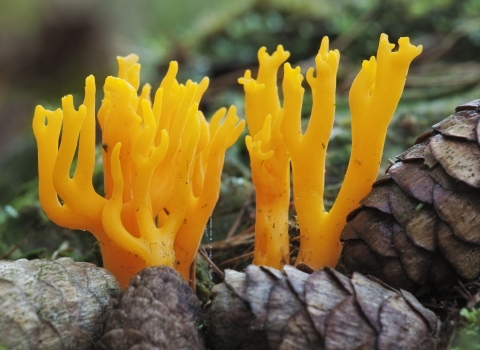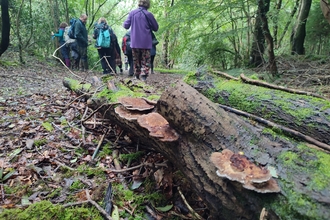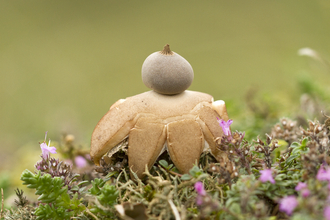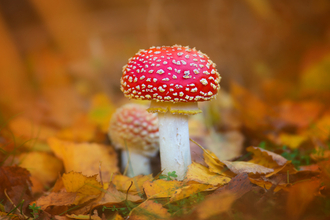Mushrooms and toadstools
With more than 15,000 species in the UK, fungi make up an entire kingdom of their own. These curious beings are neither plant, nor animal, and their diversity is stupendous. Chicken of the woods and King Alfred’s cakes, pink ballerinas and scarlet elf cups, blewits and boletes; some are delighfully named, some delicious, and others poisonous. Every habitat is home to a great variety of fungi, and autumn is the best time to explore this little-visited world: you may well be surprised at just how many you come across!
These curious beings are neither plant, nor animal, and their diversity is stupendous
Find fungi near you
You can find fungi on all of our nature reserves. Sometimes they are easy to spot, but sometimes you will need to look very closely!
An easy one to find on many nature reserves is the yellow brain fungus often found on gorse – it also looks like orange peel! Slimy but beautiful, colourful waxcap fungi adorn our grasslands each autumn. At our Eithinog Nature Reserve near Bangor, Gwynedd and Aberduna Nature Reserve near Mold, around 20 species of this group of fungi, in a delightful array of colours, have been recorded. Deep within our woodland nature reserves, such as Ddol Uchaf Nature Reserve near Caerwys or Nantporth Nature Reserve near Bangor that you’ll find even more. Around birch trees you will often find fly agaric – the archetypal fairy tale fungus! Explore the ground for tiny fungi growing on leaf litter, and look up into the trees for large bracket fungi.
How to do it
As well as many delicious wild mushrooms, fungi also include some of our most poisonous species with names as apt as the sickener, poison pie, death cap and the destroying angel. NEVER eat any fungi you find unless you are 100% certain about their identity. Unless you are with an expert, it is best to leave mushrooms where you find them - that way, others can enjoy their beauty - and go home with a photo instead.
We organise lots of fun-gi events during the autumn - visit our event pages to find out about more.
If you can't get to these places
Fungi grow in every habitat, and you certainly don’t need to go to a nature reserve to find your first toadstools: there will more than likely be several species in your garden. Encourage fungi to grow by leaving logs and branches to rot and wait to see what arrives. You’ll end up helping beetles too!
More wildlife experiences
From seeing colourful wildflowers to spotting magnificent birds of prey, we can help you get closer to wildlife across North Wales.








